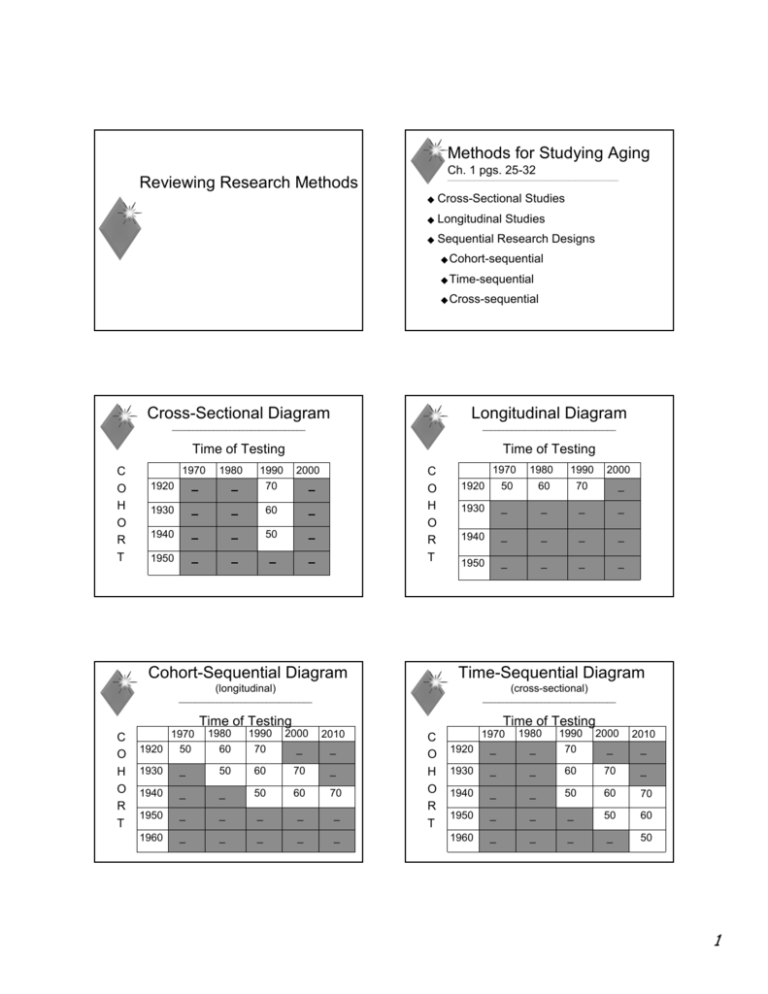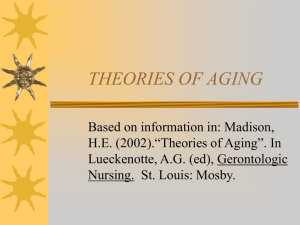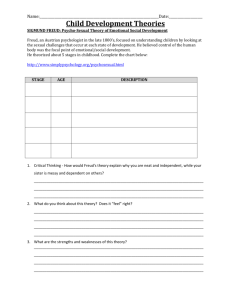February 17th session
advertisement

Methods for Studying Aging Ch. 1 pgs. 25-32 Reviewing Research Methods ___________________________________________________________________________________ ◆ Cross-Sectional Studies ◆ Longitudinal Studies ◆ Sequential Research Designs ◆ Cohort-sequential ◆ Time-sequential ◆ Cross-sequential C O H O R T Cross-Sectional Diagram Longitudinal Diagram ________________________________ ________________________________ Time of Testing Time of Testing 1920 B B 1990 70 1930 B B 60 B 1940 B B 50 B 1950 B B B B 1970 1980 2000 C O H O R T B Cohort-Sequential Diagram 1970 50 1980 1990 2000 1920 60 70 _ 1930 _ _ _ _ 1940 _ _ _ _ 1950 _ _ _ _ Time-Sequential Diagram (longitudinal) (cross-sectional) ________________________________ ________________________________ Time of Testing C O H O R T 1970 1920 50 1980 60 Time of Testing 1990 70 2000 _ 2010 _ 1930 _ 50 60 70 _ 1940 _ _ 50 60 70 1950 _ _ _ _ _ 1960 _ _ _ _ _ C O H O R T 1970 1920 _ 1980 _ 1990 70 2000 _ 2010 _ 1930 _ _ 60 70 _ 1940 _ _ 50 60 70 1950 _ _ _ 50 60 1960 _ _ _ _ 50 Cross-Sequential Diagram Methods for Collecting Data (both) ________________________________ __________________________________ Time of Testing C O H O R T 1970 1920 _ 1980 60 1990 70 2000 80 2010 _ ◆ Observation ◆ Interviews ◆ Face-to-face 1930 _ 50 60 70 _ 1940 _ 40 50 60 _ 1950 _ _ _ _ _ 1960 _ _ _ _ _ ◆ Telephone ◆ Questionnaire ◆ Mail-out or completed in presence of researcher ◆ Other Standardized Tests Develop Objectives Methods for Collecting Data (cont.) Collect Secondary Data _________________________________ ◆ Case Study ◆ Intense ◆ individual study Design Quantitative Research: •Method •Sample Design •Data Collection Instrument Clinical Method ◆ Uses sophisticated observation and interview skills ◆ Design Qualitative Research: •Method •Screener Questionnaire •Discussion Guide Conduct Research ◆ With Exploratory Study Analyze Data (subjective) Physiological research humans and animals Collect Primary Data Prepare Report Analyze Data (objective) Prepare Report Life-span Approach ________________________________ Theories of Adult Development and Aging ◆ Relatively new approach to understanding development ◆ Suggests positive developmental change occurs throughout all epochs of the life-span ◆ Terminology Development vs. Change _____________________________ ____________________________________ Life Span ◆ ◆ Total number of years for a species to live – Change ◆ approx. 110 years for the human species ◆ ◆ ◆ ◆ Longevity Average expected length of life ◆ ◆ Form of change that is organized and adaptive (positive) – children ideal learning machines, adaptive ◆ Cannot be solely equated with steady incremental change ◆ Development is a life long process Average number of years an individual has remaining to live ◆ Development Life Expectancy ◆ Measurable alterations in particular skill, ability, or function Types of Theories Freud’s Psychoanalytic Theory __________________________________ __________________________________ Individual Developmental Theories ◆ Stage Theories ◆ Non-Stage Theories ◆ and adolescence Theories of Change Across Adulthood ◆ Stage Theories ◆ Non-Stage Theories ◆ Physiological/Biological Theories of Aging ◆ Social Theories of Aging Freud’s Contributions ______________________________________ Focuses on individuals through childhood ◆ Based on the theory that drives come from within the person, not from the environment Developmental Stage Theories _____________________________ 5 Psychosexual Stages ◆ ◆ Oral (birth to 18 months) ◆ Anal (18 months – 3 years) ◆ Phallic (3 – 6 years) ◆ Latency (6 years – puberty/approx. 12 years) ◆ Genital (puberty – adolescence) No adult stages but foundation of all ◆ Erikson’s ◆ Gould’s Theory of Identity Development Theory of Individual Transformation ◆ Loevinger’s Theory of Ego Development understanding of adulthood and aging Erikson’s Theory of Identity Development Erikson’s 8 Stages ______________________________ ________________________________ ◆ ◆ Trust vs. Mistrust ◆ Most influential view of adult Autonomy vs. Shame & Doubt ◆ Initiative vs. Guilt development ◆ Industry vs. Inferiority ◆ Identity vs. Role confusion ◆ Encompasses the entire life span ◆ A gradual, stepwise development ◆ ◆ Adult Stages ◆ Intimacy vs. Isolation ◆ Generativity vs. self-absorption & stagnation ◆ Ego Integrity vs. Despair Contains 8 dilemmas Erikson’s Stages Associated With Adulthood Gould’s Theory of Personal Transformation Stages 6, 7, & 8 _________________________________ ◆ Intimacy vs. Isolation – ages 19 – 25 ◆ ◆ _____________________________ ◆ Deals with identity and relationships definition” (Gould, 1980, p. 213; In Smelser & Erikson) Generativity vs. Self-Absorption and Stagnation – ages 25 – 65 ◆ ◆ ◆ Deals with concern of developing the next generation Adult development process of working through myths Ego Integrity vs. Despair – ages 65+ ◆ A time of reflection Gould Theory Diagram Major False Assumptions _______________________________ _________________________________ $ * ( 6 Transformation is “an expansion of self ◆ The Mid-Life Decade ◆ Opening up what’s inside “I’m nobody’s baby now” ◆ Leaving our parents’ world ◆ ages 22-28 “I’ll always belong to my parents and believe in their world.” ages 16-22 “Doing things my parents’ way, with willpower and perseverance, will bring results. But if I become too frustrated, confused or tired or am simply unable to cope, they will step in and show me the right way.” “Life is simple and controllable. There are no significant coexisting contradictory forces within me.” ages 28-34 “There is no evil or death in the world. The sinister has been destroyed.” ages 35-45 Defense Mechanisms Development Without Stages Proposed by Valliant ______________________________ _________________________________ ◆ ◆ Valliant’s view of Adaptation in Adult Life ◆ Stresses ◆ ◆ the importance of career on Mechanisms ◆ projection, schizoid fantasy, hypochondriasis, passiveaggression, acting out “Neurotic” mechanisms ◆ ◆ delusional projection, denial, distortion Immature mechanisms ◆ development ◆ Defense “Psychotic” mechanisms repression, displacement, reaction formation, dissociation Mature mechanisms ◆ Altruism, humor, suppression, anticipation, sublimation Erikson – Valliant Diagram ________________________________ Theories of Adult Change A G E S Ego Integrity vs. Despair _______________________________________ Generativity vs. Stagnation Keeping the meaning vs. rigidity Intimacy vs. Isolation Career Consolidation Identity vs. Role Confusion Stage Theories of Adult Change Levinson’s Theory ____________________________ _______________________________ ◆ ◆ Levinson’s Theory: Seasons of Adulthood ◆ Life-Course Transitions: A Sociological Perspective A study of 40 men using an intensive biographical interview ◆ Life Structure is the central concept ◆ Relationships ◆ are the key component Based on a combination of phases and transitions Levinson Diagram __________________________ /DWHDGXOW 7UDQVLWLRQ &XOPLQDWLQJ OLIH VWUXFWXUH IRU PLGGOH DGXOWKRRG $JH WUDQVLWLRQ (UD RI ODWH DGXOWKRRG " (QWU\ OLIH VWUXFWXUH IRU PLGGOH DGXOWKRRG 0LGOLIH 7UDQVLWLRQ &XOPLQDWLQJ OLIH VWUXFWXUH IRU HDUO\ DGXOWKRRG (UD RI PLGGOH DGXOWKRRG $JH WUDQVLWLRQ (QWU\ OLIH VWUXFWXUH (DUO\ $GXOW 7UDQVLWLRQ (UD RI HDUO\ DGXOWKRRG (UD RI SUH DGXOWKRRG Levinson’s Model Life-course Transitions _________________________________ ◆ Role Theory ◆ Role conflict – occurs when an individual attempts to hold two or more roles that are incompatible ◆ Role strain – occurs when an individual is not a good fit for a role. Stages of Family Life Cycle 3. The family with young children 4. The family with adolescents Accepting new members into system Increase flexibility of family boundaries for children’s independence $ * ( 6 Late Adulthood Late Adulthood Transition Culmination of Middle Adulthood Age 50 Transition Entering Middle Adulthood Mid-Life Transition Settling Down Age 30 Transition Entering the Adult World Early Adult Transition Stages of Family Life Cycle Stage 1. Between families: The unattached young adult Transition Process Accepting parent offspring separation 2. The joining of families by marriage: newly married couple Committing to new system Stages of Family Life Cycle 5. The family with young adults Accepting multitude of exits from and entries into family system 6. The family in later life Accepting shifting of generational roles Requirements that Biological Theories Must Meet to be Viable Family Life Cycle – Duvall _______________________________________ Newly married, no children ◆ New parents ◆ Family with preschool children ◆ Family with school-age children ◆ Family with adolescent children ◆ Family with oldest child gone from home ◆ Family with all children gone ◆ Aging families ◆ 1. Process must be universal 2. Process must be deleterious or result in physiological decline 3. Process must be progressive & gradual 4. Loss must be intrinsic, organism cannot correct Physiological/Biological Theories of Aging ◆ Wear & Tear ◆ ◆ ◆ ◆ Immune system becomes defective and attacks itself Cross-Linkage ◆ ◆ ◆ Organism wears out Auto-Immune Protein collagen – important connective tissue Free Radical – Highly reactive molecules Cellular Aging ◆ Cells slow in number of replications Social Theories of Aging ◆ ◆ ◆ ◆ ◆ ◆ ◆ ◆ ◆ Role Theory ◆ Roles identify and describe a person as Role Theory Activity Theory Disengagement Theory Continuity Theory Age Stratification Theory Social Exchange Theory Symbolic Interactionism Labeling Theory Subculture of Aging Theory Activity Theory ◆ Based on analyses by Robert Havinghurst a social being ◆ Roles are the basis of self-concept ◆ Examples: mother, father, student, etc. ◆ The more active the older person, the greater his or her satisfaction, positive self-concept, and adjustment in later life will be Disengagement Theory ◆ Viewed as an adaptive behavior ◆ Allows older people to maintain a Continuity Theory ◆ Individuals maintain a consistent pattern of behavior as they age ◆ The aging individuals substitute similar types of roles for lost ones ◆ Life satisfaction is determined by how consistent activities or lifestyles are with lifetime experiences sense of self-worth while adjusting to the loss of prior roles Age Stratification Theory ◆ Directs attention away from Social Exchange Theory ◆ activity decrease with age individual adjustment ◆ ◆ Adds a structured time component ◆ Recognizes that members of one strata differ from each other Attempts to answer why social interaction and Withdrawal and social isolation results from an unequal exchange between the elderly and society ◆ Exchange may be driven by emotional needs and resources Symbolic Interactionism ◆ Proposes that, in certain contexts, disengagement can be the norm ◆ The context and the environment must be considered before an evaluation can be made about whether a behavior is positive or negative Labeling Theory ◆ Derived from Symbolic Interaction Theory ◆ Proposes that we react to the way others treat us by adapting our behavior to fit the definition others have set for us Summary of Micro Theories of Aging Subculture of Aging Theory ◆ ◆ ◆ ◆ Suggests that individuals interact with others who have similar interests and backgrounds. This may leave older individuals feeling isolated from other segments of society. This may also allow for positive interaction to occur. 2 consequences for older people: 1. 2. ◆ involves a natural & inevitable withdrawal from society ◆ nor inevitable to withdraw Summary of Micro Theories of Aging Continuity theory - Normal aging involves a continuity in personality structure & in patterns of social interaction ◆ Exchange theory - Interaction between young & old declines because elderly have few resources to bring to an exchange relationship ◆ ◆ ◆ Age stratification theory - All societies group people into age categories, & age represents a powerful source of social stratification ◆ Modernization theory - Although aged were revered in past, modernization caused status of aged to decline Loevinger’s Stages of Ego Development ______________________________ _____________________________________ sequential, cumulative stages Different from Erikson’s ◆ Stages ◆ The Summary of Macro Theories of Aging Loevinger’s Theory of Ego Development Similar to Erikson’s ◆ 10 Activity theory - Elderly are no different from middle-aged, it is neither natural A classification of being old An affiliation with a growing group that may be influential socially and politically ◆ Disengagement theory - Normal aging ◆ Pre-social Stage ◆ Self-aware Level ◆ Symbiotic Stage ◆ Conscientious Stage ◆ Impulsive Stage ◆ Individualistic Level ◆ Self-protective Stage ◆ Autonomous Stage ◆ Conformist Stage ◆ Integrated Stage are not inevitable individual must move through a stage successfully before moving on Theories of Change Without Stages Theoretical Syntheses ______________________________ ______________________________ ◆ Baltes’s Life-Span Perspective ◆a ◆ ◆ ◆ perspective - not a theory Perun & Bielby’s Timing Model of Adult Development ◆ synchrony ◆ temporal vs. asynchrony progressions Pearlin’s Model of Psychological Distress in Adults ◆ Focuses primarily on the sources of and methods of dealing with stress in the adult years Three sources of distress: ◆ Daily life strains ◆ Scheduled life strains ◆ Unscheduled life strains






